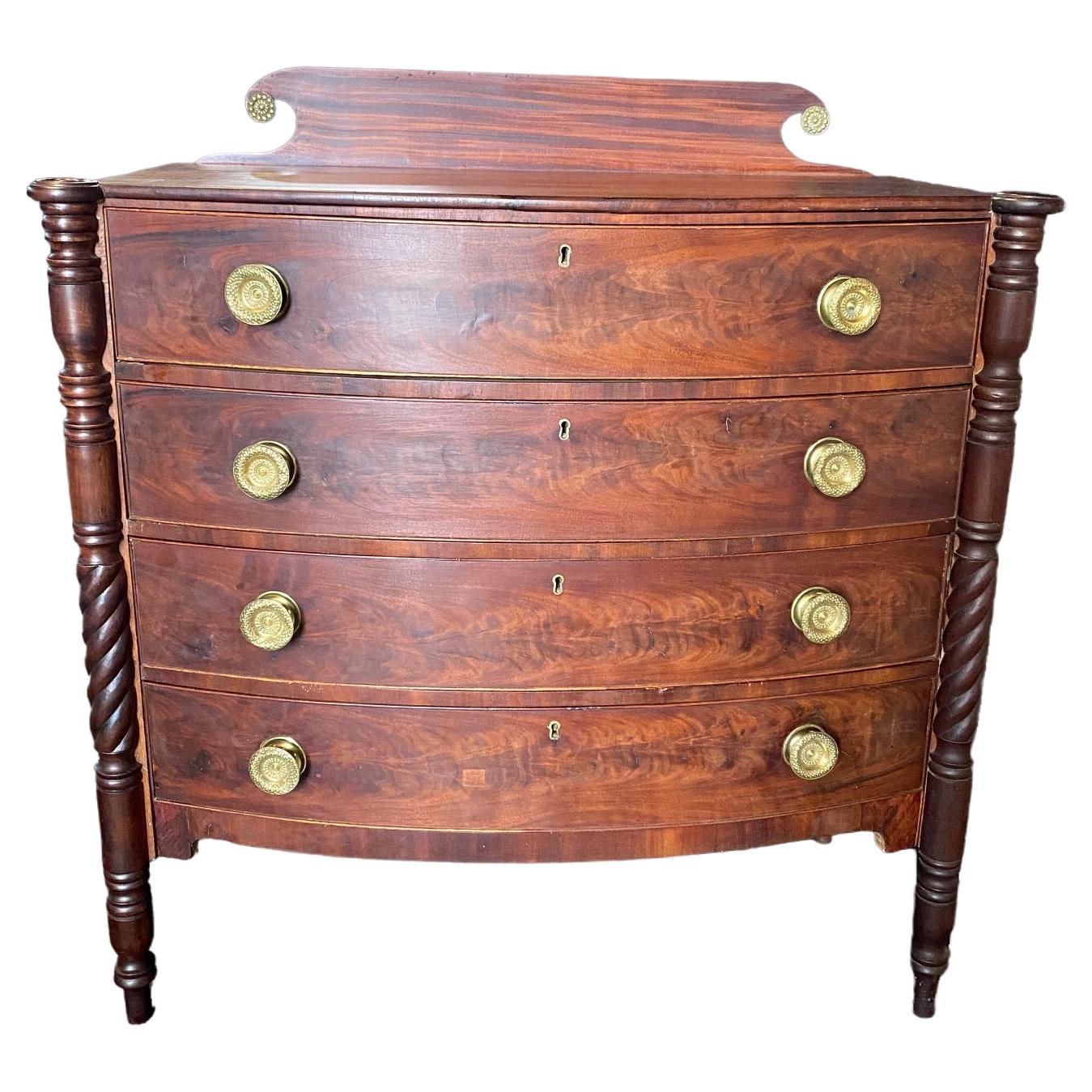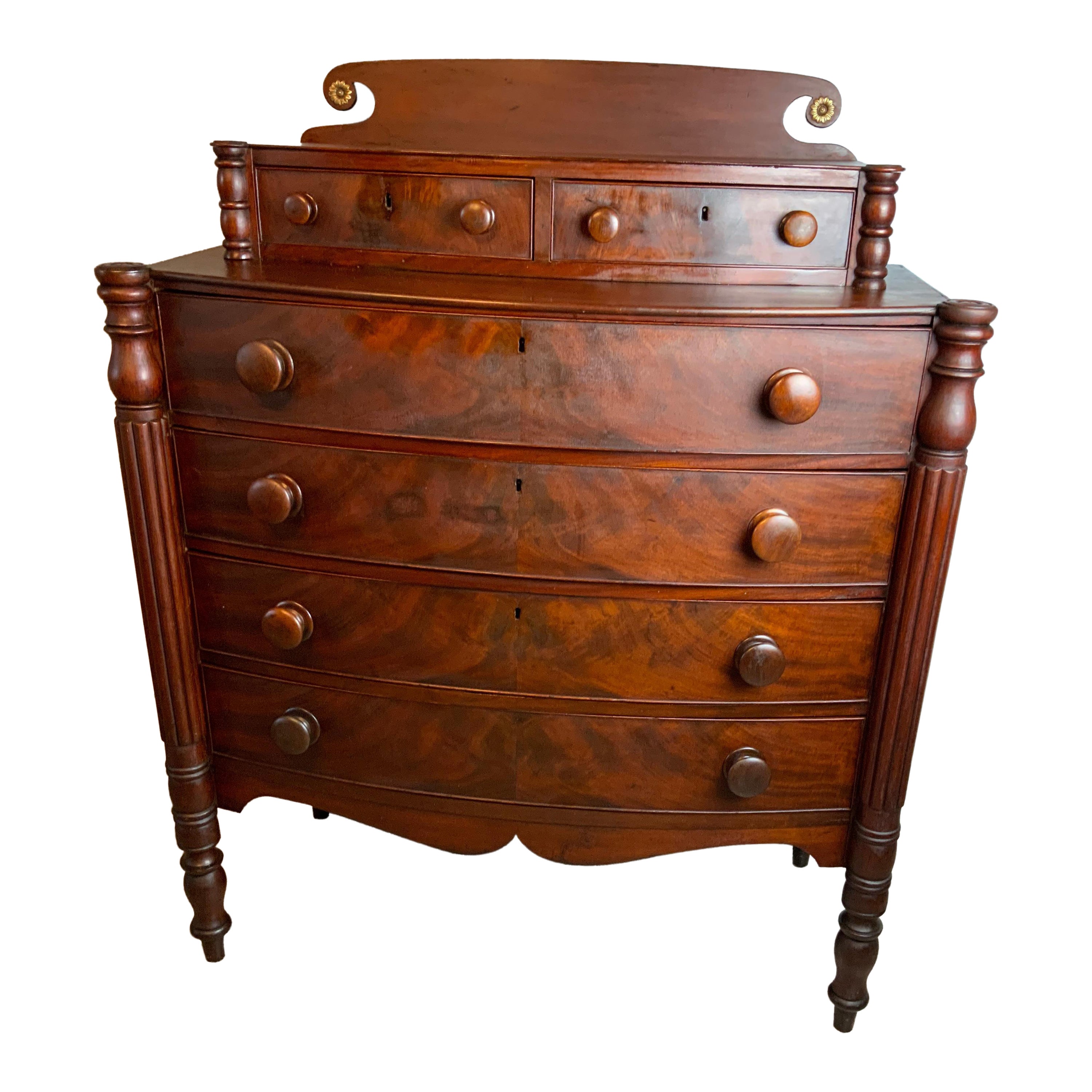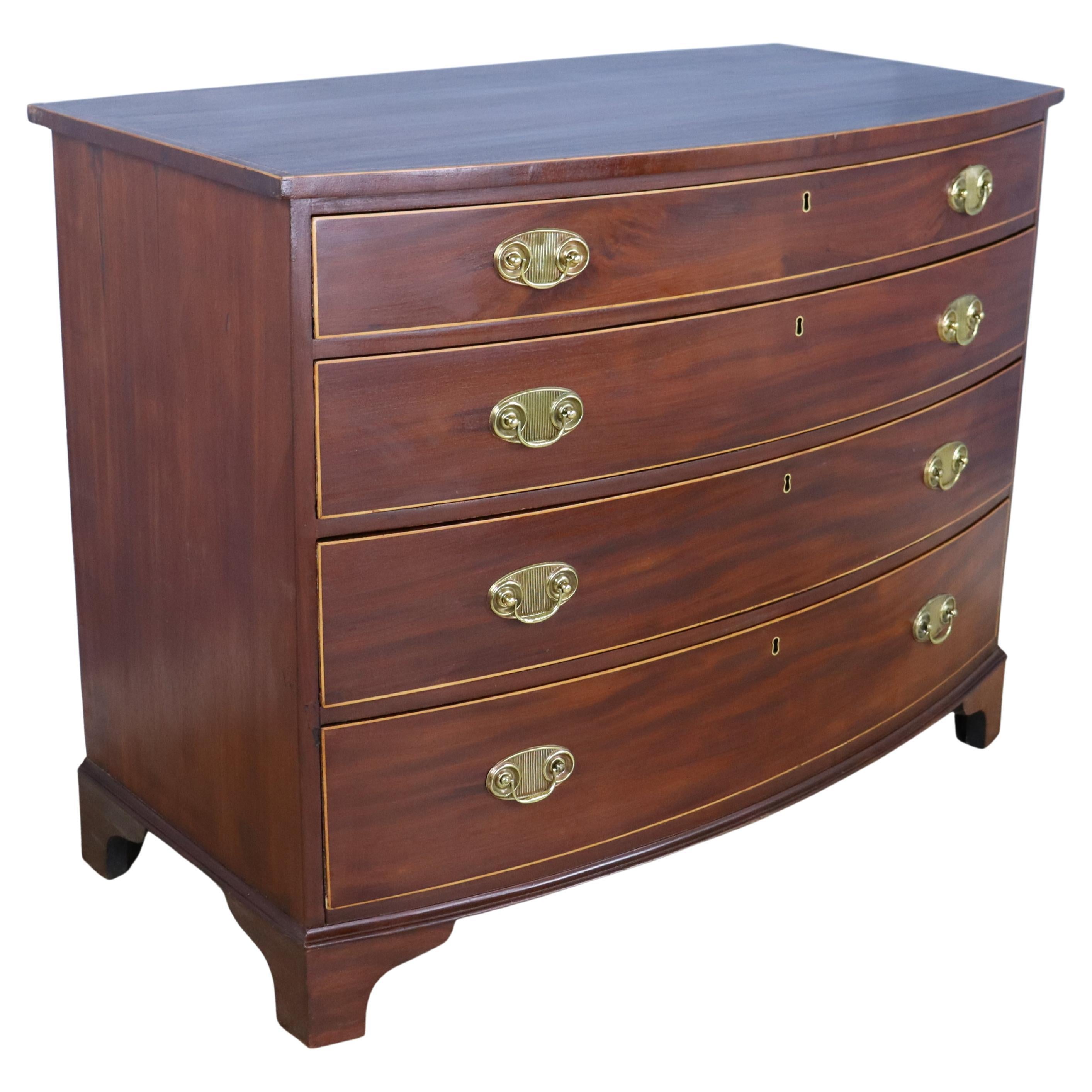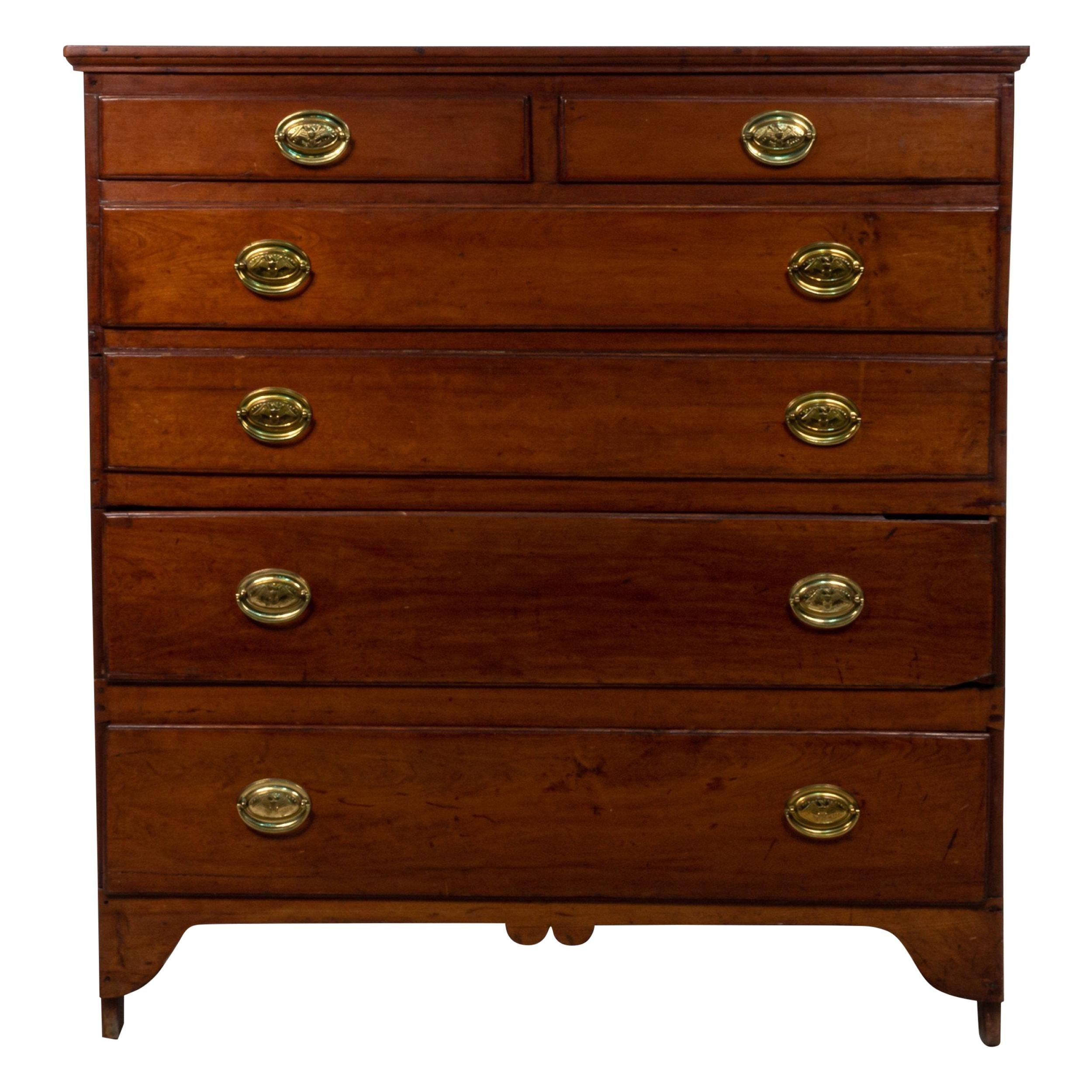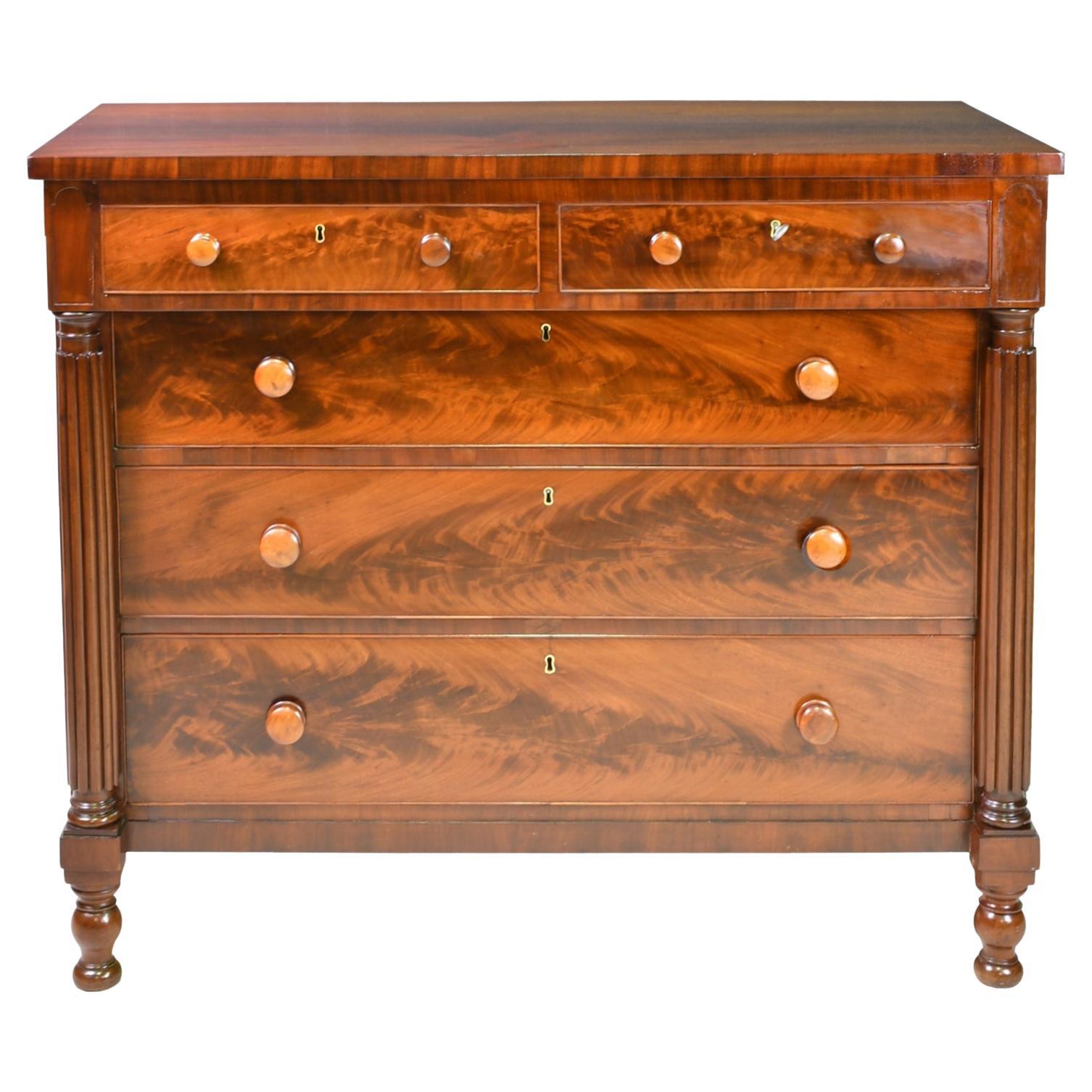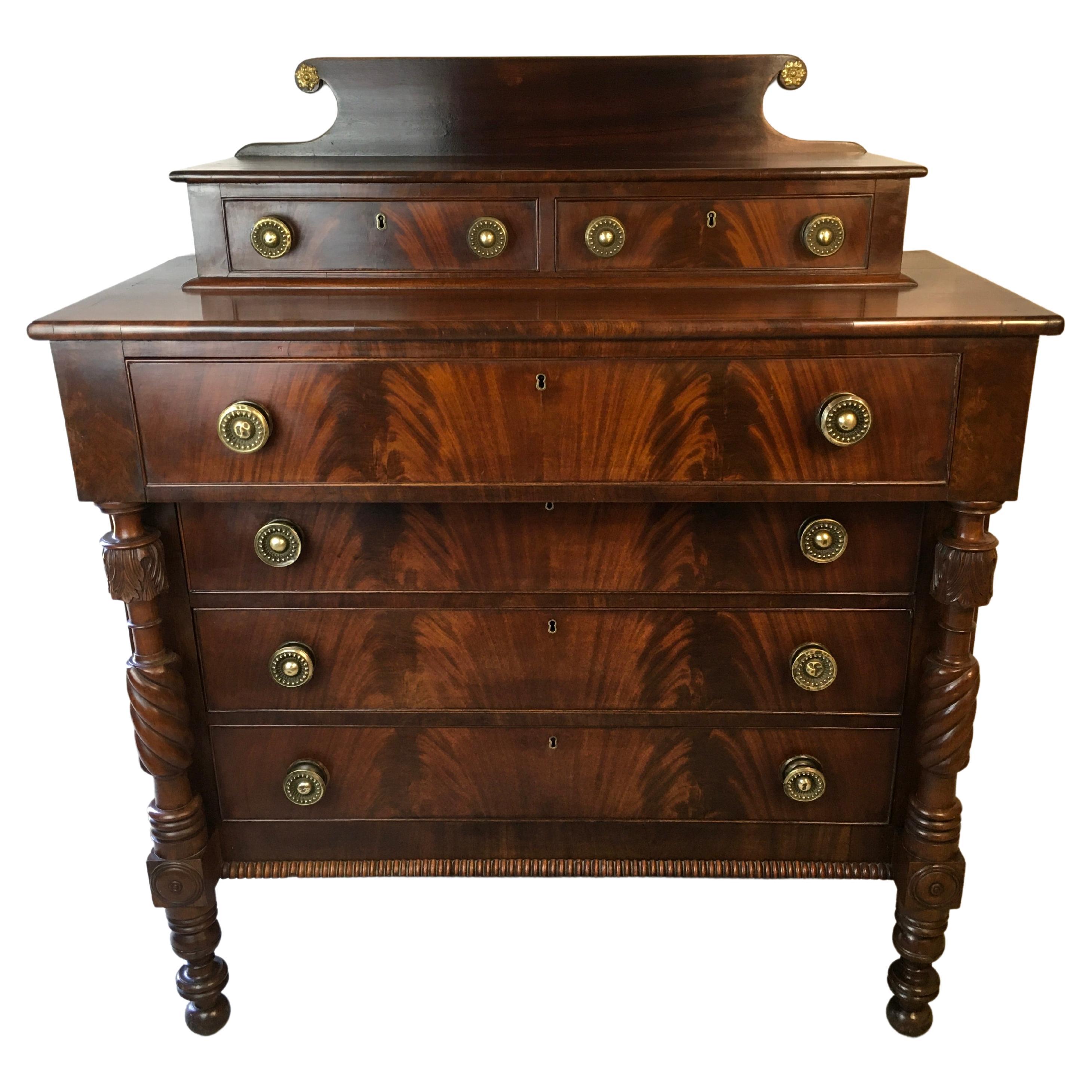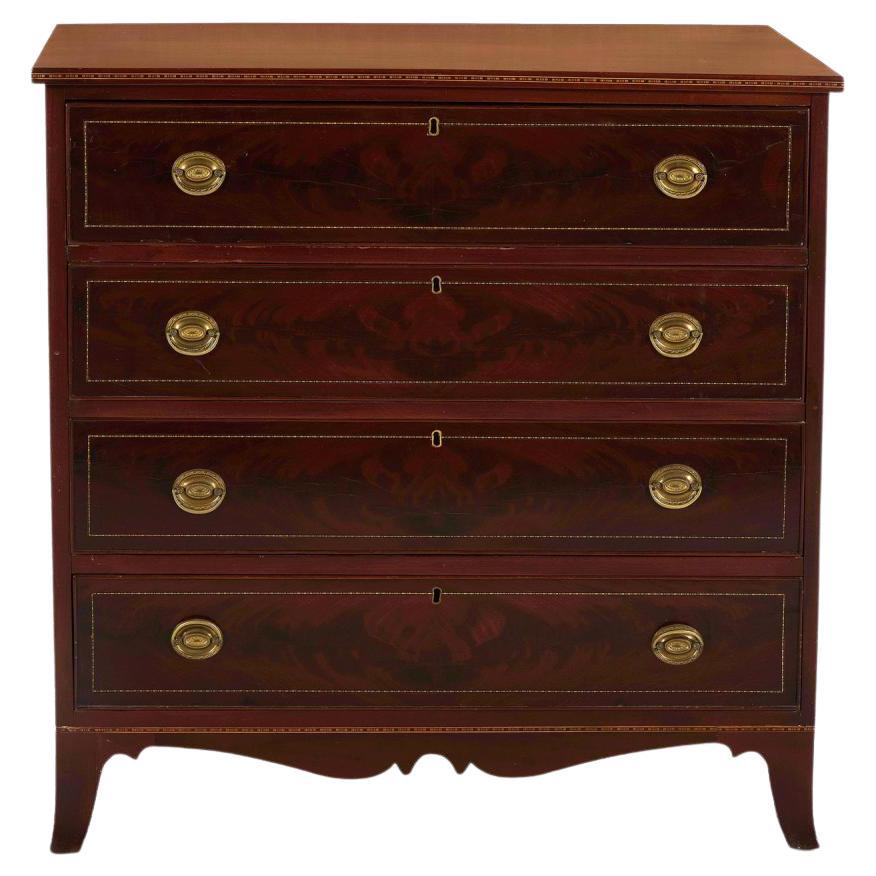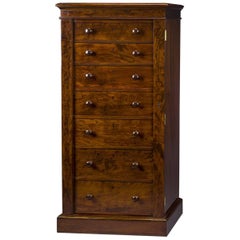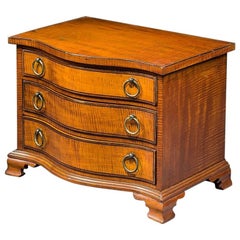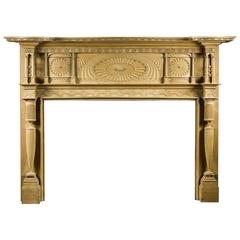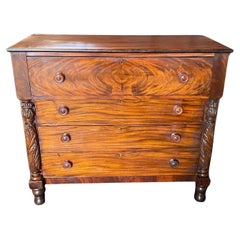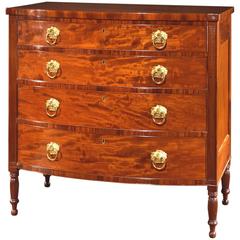
Late Federal Chest of Drawers in the Sheraton Taste
View Similar Items
Want more images or videos?
Request additional images or videos from the seller
1 of 2
Late Federal Chest of Drawers in the Sheraton Taste
About the Item
- Dimensions:Height: 41.13 in (104.48 cm)Width: 42.63 in (108.29 cm)Depth: 23.44 in (59.54 cm)
- Style:Federal (Of the Period)
- Materials and Techniques:
- Place of Origin:
- Period:
- Date of Manufacture:1810-1815
- Condition:CONDITION: Excellent. Cleaned and French polished. Some shrinkage cracking to veneer on top of chest, as usual. The extremely fine basket-of-flowers drawer pulls are original. Their gilt-lacquer finish has been redone.
- Seller Location:New York, NY
- Reference Number:Seller: FAPG 19988D1stDibs: LU90327053383
About the Seller
No Reviews Yet
Recognized Seller
These prestigious sellers are industry leaders and represent the highest echelon for item quality and design.
Established in 1952
1stDibs seller since 2010
Typical response time: 1 to 2 days
Associations
Art Dealers Association of America
More From This SellerView All
- Seven-Drawer Tall Chest of DrawersLocated in New York, NYBoston, Massachusetts Seven-drawer tall chest, circa 1825. Mahogany (secondary woods: mahogany, pine, and poplar) Measures: 45 5/8 in. high, 27 5/8 in. wide, 14 5/8 in. deep Inscribed (on six drawer locks): SECURE; (on seventh lock): CHUBB’S / PATENT / 57 St PAULS CHY / LONDON / CHUBB & SON / MAKERS TO / HER MAJESTY / 632284; (on one hinge): [BUR?] NE PATENT; (on master lock): 2 LEVER. Although some Boston furniture of the Neo-Classical period is elaborately decorated with ormolu mounts, brass moldings, and carved and gilded elements, other pieces are more simple and are said to reflect the “conservative” taste of many of Boston’s great families. The simplicity evident in these pieces is not an indication of a less-expensive line of furniture or a less-sophisticated patronage, but, like the so-called “Grecian Plain Style” of Duncan Phyfe’s furniture...Category
Antique 1820s American Neoclassical Commodes and Chests of Drawers
MaterialsMahogany
- Miniature Striped-Maple Serpentine Chest of DrawersLocated in New York, NYAmerican, probably Boston or Salem, Massachusetts Miniature Serpentine Chest of Drawers, circa 1785-1800 Striped maple, ebony, and rosewood (secondary woods: mahogany), with brass dr...Category
Antique 1780s American Chippendale Commodes and Chests of Drawers
MaterialsWood
- Fan-Carved Wood Mantel in the Federal TasteLocated in New York, NYNew York, Fan-carved mantel in the Federal taste, circa 1812 Pine Measures: 66 1/4 in. high, 90 3/8 in. wide, 13 1/4 in. deep Within the genre of carved rather than plasterwork mantels of the Federal Period, no example that has come to light is more perfectly designed or more carefully wrought than the present one, which is an amazing symphony of fans, urns, beads, and other Neo-Classical devices, all ultimately influenced by the plasterwork designs of the English architects Robert (1728–1792) and James (1732–1794) Adam. Of a type that proliferated in the area bounded by the northern New Jersey counties of Bergen and Passaic, the Hudson Valley, and western Long Island, the mantel is representative of work that flourished in the first couple of decades of the 19th century. While most of the woodwork of this style that has survived is found in interiors, various examples of exterior doors and other trim have been noted, but most examples have disappeared as a result, variously, of natural deterioration and purposeful demolition in anticipation of development. Although considerably larger in scale and more elaborate in ornament than a mantel that has been in the collection of the Brooklyn Museum since 1944 (acc. no. 44.55; photograph in Hirschl & Adler archives), the present mantel is so close in style and conception to that example that it likely originated in the same house. The Brooklyn mantel is documented as having been removed from a house built by Judge Isaac Terhune (1762–1837), an eminent lawyer and judge. The house was situated on King’s Highway, at the corner of Mansfield Place, at the edge of South Greenfield, a village in northern Gravesend, Brooklyn. A photograph of the house, taken by the German e´migre´ photographer, Eugene Armbruster (1865–1933), is in the collection of the New-York Historical Society. Terhune is ultimately descended from the Dutch-Huguenot e´migre´ Albert Albertson Terhunen, who died in Flatlands, Brooklyn, in 1685.The family eventually spread out through New Amsterdam, Long Island, and Bergen County, New Jersey. Terhune’s great-grandson, also Albert (1715–1806), left a sizable estate to his six surviving children, including his second child and second son, Isaac. Judge Terhune lived in the house until his death in 1837, at which time, according to an article in The New York Times for November 27, 1910, he, having died without issue, “left the White Frame Mansion with its exquisitely carved doorway, beautiful mantels, and other interior adornments to his brother John” (Part Six, p. 11). The article continues: After the latter’s death, the house and its estate of about 70 acres passed through several owners, eventually being purchased in 1853 by Benjamin G. Hitchings [1813–1893]. The house next passed to Benjamin’s son, Hector, who had been born in the house, and then lived there for 25 years. He sold it in 1910 in partial payment for a Manhattan apartment house. After thus having been sold to a real estate developer, the Hitchings property was subdivided into Hitchings Homestead. The house survived until about 1928, at which time it was razed and a Deco-style apartment house with the address 2301 Kings Highway was constructed on the site and occupied in 1935. By 1910, the fate of the house, in an area of Brooklyn that was being rapidly developed, was becoming obvious. The Times article reported: The house has been well kept up, but fearing lest the hand of time or vandals might deal harshly with some of its choice bits of carving, Mr. Hitchings removed a few years ago a few beautifully carved wood mantels...Category
Antique 1810s American Neoclassical Fireplaces and Mantels
MaterialsWood
- Small Settee in the Neoclassical TasteLocated in New York, NYSmall Settee in the neoclassical taste Boston, Massachusetts (active 1804–17), about 1810 Mahogany (secondary woods: ash) Measures: 35 1/8 in. high, 59 3/4 in. long, 19 1/8 in. deep Although the diminutive scale of this settee places it in a unique category, the piece itself partakes of a vocabulary that is common in Boston furniture of the Late Federal period. Its sabre legs, for example, as seen straight on from the left and right ends, are closely related to the legs, as seen from the front, on a group of chairs of undisputed Boston origin, including a spectacular armchair with scrolled arms (see Stuart P. Feld, Boston in the Age of Neo-Classicism, 1810–1840, exhib. cat. [New York: Hirschl & Adler Galleries, 1999], p. 37 no. 6 illus. in color), as well as a number of side chairs, including a set made for Nathan Appleton (see Page Talbott, “Boston Empire Furniture, Part I,” The Magazine Antiques, CVII [May 1975], p. 887 fig. 12). In all, the legs are ornamented with two bold, somewhat flattened reeds set between corner beads, a pattern which is repeated here on the front and end seat rails as well. The superb quality of the piece is further demonstrated in the finely drawn profile of the arms, as well as the delicately bulbous surface of the fronts of the arms and legs. As in the best of the related chairs, the sabre legs end in delicately carved paw feet. The added refinement of the beautifully carved rosettes at both the fronts and backs of the arms suggests that the piece may have been designed to be used in the round. Stylistically harmonious with these pieces is also a group of larger sofas with frontally set sabre legs and scrolled arms (see Page Talbott, “Seating Furniture in Boston, 1810–1835,” The Magazine Antiques, CXXXIX [May 1991], p. 963 pl. 11) that represent an indigenously Boston form. Although none of the furniture in this group has been effectively attributed, they can certainly be related to various Boston card tables...Category
Antique Early 19th Century American Neoclassical Settees
MaterialsWood
- Card Table in the Rococo TasteBy Charles A. BaudoineLocated in New York, NYRECORDED: cf. Anna Tobin D’Ambrosio, ed., Masterpieces of American Furniture from the Munson-Williams-Proctor Institute (Syracuse University Press, Utica, New York, 1999), pp. 85, 86, 87 illus. the Munson-Williams-Proctor tables // cf. The Metropolitan Museum of Art, New York, 19th Century America–Furniture and Other Decorative Arts (1970), exhib. cat., [n.p.] no.133 This table is identical to a pair of card tables bearing the stenciled label of Charles A. Baudouine of 335 Broadway, New York, which were acquired by James and Helen Munson Williams of Utica, New York, in May 1852 for their home, Fountain Elms, which is where they remain today as part of the Munson-Williams-Proctor Art Institute collection. The Williams tables were billed as “1 Rosewood Multiform Table” at $160 for the pair, and they were indeed “multiform” in that they could be used separately and folded as a pair of console tables, opened as a pair of card tables, or joined together as a center table. The present table varies essentially in the fact that it does not include the mechanism that would have allowed it to be attached to another to form a center table. Of French descent, Baudouine was born in New York in 1808. He made his debut as a cabinetmaker in the New York directory of 1829/30, where he is listed at 508 Pearl Street. By 1839/40 he relocated to Broadway, where he remained in business at various addresses until about 1854. A sense of the scale of Baudouine’s operation is given by German immigrant cabinetmaker Ernest Hagen...Category
Antique Mid-19th Century North American Rococo Revival Card Tables and T...
MaterialsWood, Rosewood
- Pier Mirror in the Neoclassical TasteLocated in New York, NYNew York, circa 1815-1820. Wood, gessoed and gilded, with mirror plate. 75 1/2 in. high, 44 1/8 in. wide (at the cornice), 8 1/2 in. deep (at the cornice). Condition: Some restorati...Category
Antique 19th Century American Neoclassical Pier Mirrors and Console Mirrors
MaterialsMirror, Wood
You May Also Like
- Federal Early 19th Century Sheraton Bow Front Cookie Corner Chest of DrawersLocated in Hopewell, NJExceptional early 19th century Sheraton bow front chest of drawers. The case is constructed of lovely flame mahogany. There are four drawers a...Category
Antique Early 19th Century American Federal Commodes and Chests of Drawers
MaterialsBrass
- American Federal Mahogany Chest Of DrawersLocated in Essex, MARectangular top with pinched corners over four graduated drawers with oval brass handles. Bracket feet.Category
Antique 1790s American Federal Commodes and Chests of Drawers
MaterialsMahogany
- Early American Federal Chest of Drawers in Bookmatched MahoganyLocated in Hopewell, NJFrom the Federal period, a very beautiful American Neoclassical chest of drawers in fine bookmatched mahogany with one overhanging drawer supported on the sides by two beautifully tu...Category
Antique 19th Century American Federal Commodes and Chests of Drawers
MaterialsMahogany
- American Sheraton Chest Of DrawersLocated in Bradenton, FLOne of the cleanest and most original American Sheraton chests we’ve had. This piece is in its original finish and retains all the original w...Category
Antique Early 19th Century American Sheraton Commodes and Chests of Drawers
MaterialsMahogany
- Sheraton Bowfront Chest of DrawersLocated in Port Chester, NYA striking Sheraton bowfront chest of drawers, the Sheraton style being characterized most notably by contrasting veneer inlays. In this piece ...Category
Antique 19th Century English Commodes and Chests of Drawers
MaterialsMahogany, Satinwood
- American 18th Century Federal Mahogany Chest of DrawersLocated in Carmel, CASheraton style chest with four graduated drawers with inlay banding and cock beading about the perimeter. The chest has a curvaceous apron and Fr...Category
Antique Late 18th Century American Federal Commodes and Chests of Drawers
MaterialsMahogany
Recently Viewed
View AllMore Ways To Browse
Antique 5 Drawer Chest Of Drawers
Antique Sheraton Chest Of Drawers
Tulip 42
Chest On Chest Sheraton
Federal Mahogany Chest
Antique 8 Drawer Chest
Antique Brass Wood Basket
Pennsylvania Chests Of Drawers
Tulip Chest
Federal Mahogany Chest Of Drawers
Philadelphia Chest
Mahogany 5 Drawer Chest
Federal Chest On Chest
5 Drawer Mahogany Chest Of Drawers
7 Drawer Antique Chest Of Drawers
Basket Tulip
5 Drawer Commode French
Philadelphia Chest Of Drawers
